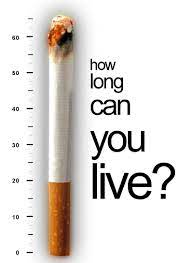By: Mohammad Hanief
Smoking affects everything from the appearance of your skin and nails to how your tissues, organs and even your DNA work. The effects of smoking on your body start the moment you light up a cigarette. Thousands of chemicals released from burning tobacco start their damaging journey before you’ve even taken a puff.
The heat from burning the cigarette releases nicotine and creates tar (tobacco residue). As you bring the cigarette to your lips, the tar stains your nails. The smoke dries out and inflames your skin, deepening wrinkles. Inhaling smoke through your nose damages nerve endings. Over time, this reduces your sense of smell.
When you take a puff from the cigarette, it goes through a filter. This mostly keeps you from breathing in large particles, but tar, nicotine and other chemicals still get through. The tar stains your teeth and coats your gums and tongue. It damages your tooth enamel, puts you at risk for tooth decay and gum disease, and reduces your ability to taste foods you love.
Your liver processes nicotine and you pee it out within a few hours of smoking a cigarette. Your body misses the buzz and craves more, encouraging you to have another one. If you don’t, you experience symptoms of withdrawal, like anxiety, depression, restlessness, anger and insomnia. Your body will develop a tolerance to nicotine and eventually need more and more to make you feel good, leading to nicotine dependence.
Jammu and Kashmir Union Territory has been identified as having the 6th highest prevalence of tobacco use in the country, with over 20 percent of the population engaging in tobacco consumption, according to officials.
The prevalence of smoking tobacco in the region stands at 20.8%, ranking it sixth in the country, following Manipur, Arunachal Pradesh, Tripura, Meghalaya, and Mizoram while the relevance of smokeless tobacco in Jammu and Kashmir is the lowest in the country at 4.3%, just after Himachal Pradesh.
According to the Global Adult Tobacco Survey (GATS) 2 data, 35.2% of men, 5.1% of women, and 20.8% of all adults in Jammu and Kashmir smoke tobacco. It adds that 6.8% of men, 1.5% of women, and 4.3% of all adults currently use smokeless tobacco. Overall, 39.7% of men, 6.2% of women, and 23.7% of all adults either smoke tobacco or use smokeless tobacco.
The government has implemented numerous measures to reduce tobacco consumption. Over the past four years, thousands of challans have been issued and substantial fines collected from violators for smoking in public places in the Kashmir division. These efforts have resulted in hundreds of people quitting smoking, with thousands receiving counselling and pharmacotherapy sessions.
Various awareness programmes and initiatives have already been launched in Jammu and Kashmir to educate the public about the hazards of tobacco use, and officials have been instructed to carry out regular enforcement drives for the implementation of COTPA-2003.
Official data reveals that smokers and tobacco users are 2.5 times more likely to develop tuberculosis (TB) as tobacco use raises the risk of TB, increases recurrence, and impairs treatment.
The government of Jammu and Kashmir has already imposed a complete ban on the sale of loose cigarettes, loose bidis, and loose tobacco. All educational institutions and tourist destinations have been declared tobacco-free zones.
The available media reports reveals that among both males and females, the prevalence of cigarette smoking is higher in urban areas but the prevalence of all other smoking products is higher in rural areas. The prevalence of each of the smokeless tobacco product is higher in rural than urban areas, however, gutkha is almost equally prevalent in both urban and rural areas.
On an average a daily cigarette smoker in India smokes 6.1 cigarette sticks per day, and a daily bidi smoker smokes 11.5 bidi sticks per day. One-fourth of daily cigarette smokers smoke more than 10 cigarettes per day, and more than half of the daily bidi smokers smoke more than 10 bidis per day.
Tobacco use is a major risk factor for many chronic diseases, including cancer, lung disease, cardiovascular disease and stroke. It is one of the major causes of death and disease in India and accounts for nearly 1.35 million deaths every year. India is also the second largest consumer and producer of tobacco.
Tobacco is recognised as the leading cause of preventable deaths worldwide, killing over seven million people globally and more than one million in India annually. Lung cancer has emerged as the second most common cancer, and in recent decades, Kashmir has seen a rise in cases of lung and breast cancers.
Hospital-based data from the Kashmir valley reveals a higher incidence of lung cancer among males, directly correlated to the duration and frequency of smoking. While quitting smoking reduces the risk of developing cancer, the risk does not disappear entirely.
Half of the current smokers believed they could quit if they wanted to, and around 40 percent had quit smoking in the past year, citing various reasons for quitting as it is crucial to address tobacco use among adolescents and enhance awareness of its dangers, given the increasing prevalence and widespread exposure to environmental tobacco smoke.
There are many ways through which one can quit smoking. The first one is preparing for the day when you will quit. It is not easy to quit a habit abruptly, so set a date to give yourself time to prepare mentally.
Thus, if anyone is a slave to cigarettes, it is essential for them to understand that it is never too late to stop smoking. With the help and a good action plan, anyone can quit it for good. Moreover, the benefits will be evident within a few days of quitting.
(The author can be mailed at [email protected], X/Twitter: @haniefmha)


